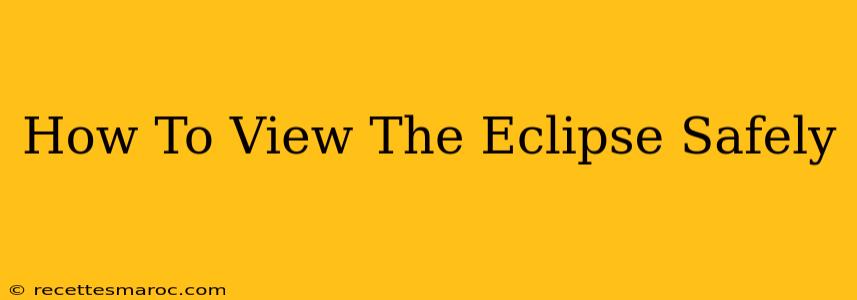Witnessing a solar eclipse is a breathtaking experience, but safe viewing is paramount. Looking directly at the sun, even during a partial eclipse, can cause serious and permanent eye damage, including blindness. This guide provides essential information on how to safely observe this spectacular celestial event.
Understanding the Dangers of Direct Sun Exposure
The sun's intense radiation, even during an eclipse, can severely damage the retina, the light-sensitive tissue at the back of your eye. This damage can be irreversible, leading to solar retinopathy, a condition characterized by blurred vision, blind spots, and, in severe cases, complete vision loss. Never look directly at the sun without proper eye protection.
Why Special Glasses are Necessary
Regular sunglasses, even very dark ones, do not offer sufficient protection against the sun's harmful rays. Only ISO 12312-2 certified solar viewing glasses are safe for direct solar observation. These glasses are specifically designed to filter out harmful ultraviolet (UV) and infrared (IR) radiation.
Safe Methods for Eclipse Viewing
Here are several safe ways to witness the eclipse:
1. Using ISO-Certified Solar Viewing Glasses
This is the most straightforward and recommended method. Ensure your glasses are ISO 12312-2 certified. Check the manufacturer's information and packaging carefully. Inspect the glasses before each use, discarding any that are scratched or damaged.
Important Considerations:
- Children should be supervised at all times while using solar viewing glasses.
- Never look at the sun through binoculars, telescopes, or cameras without the appropriate solar filters specifically designed for such equipment. Improperly used filters can magnify the sun's intensity, causing immediate and severe eye damage.
- Take breaks during viewing to avoid eye strain.
2. Pinhole Projection
This is a simple and safe method that doesn't require special glasses. Here's how to do it:
- Make a pinhole: Punch a small hole in a piece of cardboard.
- Project the image: Hold the cardboard with the pinhole in front of the sun, and project the sun's image onto another piece of white cardboard behind it.
- Adjust the distance: Adjust the distance between the two pieces of cardboard to obtain a clear image of the sun.
This method allows you to view the eclipse indirectly, eliminating the risk of eye damage.
3. Watching the Eclipse Online or Through Live Streams
Many organizations will stream the eclipse live, offering a safe and convenient way to experience the event without risking your eyesight. This is an excellent option for those in areas with unfavorable weather conditions or those who might find it challenging to obtain certified solar glasses.
After the Eclipse: Checking for Eye Damage
Even with proper precautions, it's always a good idea to be vigilant. After the eclipse, check for any unusual symptoms, such as blurred vision, distortion, or floaters. If you experience any of these, consult an ophthalmologist immediately.
In Conclusion:
Enjoying a solar eclipse is a once-in-a-lifetime opportunity. By prioritizing safe viewing practices, you can marvel at this awe-inspiring celestial event without compromising your vision. Remember, safety always comes first! Never look directly at the sun without proper eye protection.

